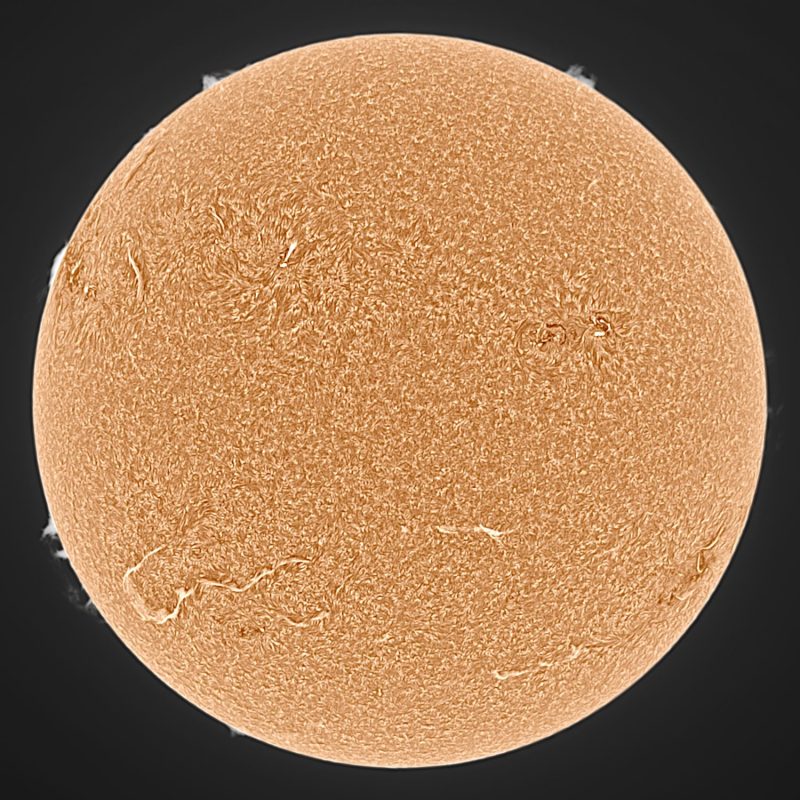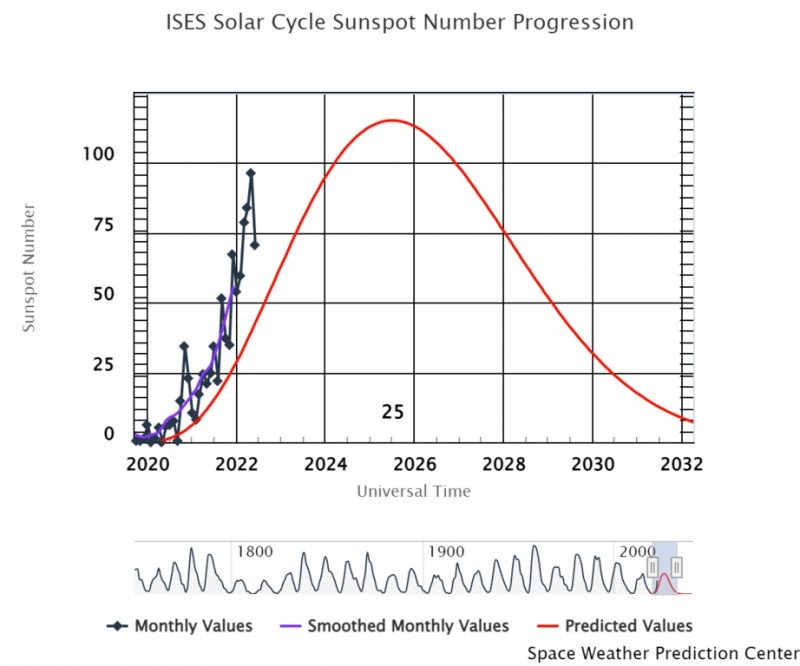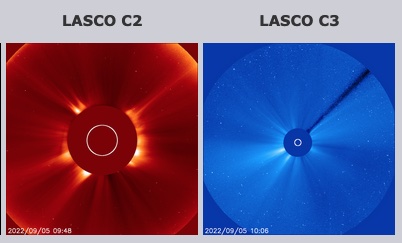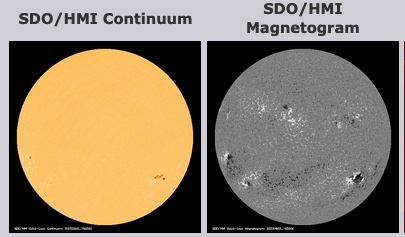
Solar Cycle 25 is due to peak around the middle of this decade. And, in late 2022 and early 2023, we’ve seen a lot of solar activity! Here are some terms that might help you appreciate the dazzling ups and downs of our local star.
Follow the sun’s behavior each day, in EarthSky’s daily sun activity articles.

Sun glossary: A
Active Region (AR): Areas of the sun where the magnetic fields are very strong. They appear very bright in ultraviolet and X-ray wavelengths. In visible light they appear as sunspots. Labeled regions on the sun take their names from these active regions. For example, the giant sunspot of January 2023 was AR3190.
Auroras: Glowing lights in the sky, most often appearing at northerly latitudes. Charged particles colliding with the Earth’s magnetic fields ignite these lights. We see them as aurora borealis (northern lights) and aurora australis (southern lights). Read more about what causes the aurora.
Sun glossary: C
Cannibal CME A double load of plasma. It occurs when two CMEs erupt off the sun at the same time. If the second CME overtakes and consumes the first, a CME combination forms. Cannibal CMEs contain tangled magnetic fields and compressed plasmas, which can cause severe geomagnetic storms.
Chromosphere: The layer of the sun’s atmosphere between the photosphere and the corona. It looks like little blades of grass along the edge of the sun and as the glowing red or pink rim around an eclipsed sun before the corona appears. The chromosphere is hotter than the photosphere but not as hot as the corona.
Convection zone: The outer region (roughly 1/3) of the sun that transports energy through the rising and sinking of gas, like a bubble in a pan of boiling water. A bubble of gas that is hotter than surrounding gas expands and rises. After passing on its heat to its surroundings, it cools and sinks again.
Corona: Outer atmosphere of the sun. The corona consists of plasma (ionized gases) exceeding 1 million degrees kelvin. You can see it with the unaided eye during a solar eclipse.
Coronagraph: A telescope using some sort of disk to cover or blot out the sun while observing the corona.
Coronal holes: An area of the corona that appears dark. They are usually located at the poles of the sun. The magnetic field lines in a coronal hole extend out into the solar wind.
Coronal jets: Coronal jets are narrow ejections of solar plasma typically from solar active regions. The plasma is observed in the corona primarily in extreme-ultraviolet and x-ray light. These jets are driven by the same magnetic energy release process that drive solar flares and coronal mass ejections. They may provide a better understanding of coronal heating, solar wind acceleration and the similar phenomena of spicules.
Coronal Mass Ejection (CME): Occurs when a huge magnetic bubble of plasma erupts from the sun, traveling rapidly out into space.
Coronal streamers: Large magnetic structures in the sun’s corona.
Co-rotating interaction region (CIR): A CIR is a structure created when high-speed solar wind bunches up with slower solar wind, creating a concentration of solar plasma and magnetic field that can act similar to a slow CME when it reaches Earth. It can cause an increase in geomagnetic activity.
C2 images: LASCO images (via SOHO) that show the inner solar corona up to 5.25 million miles (8.4 million kilometers ) away from the sun.
C3 images: LASCO images (via SOHO) that have a larger field of view: They encompass 32 diameters of the sun. To put this in perspective, the diameter of the images is about 30 million miles (45 million kilometers) at the distance of the sun, or half of the diameter of the orbit of Mercury. You can see many bright stars behind the sun.
Sun glossary: E
EIT (Extreme ultraviolet Imaging Telescope): These are SOHO images of the solar atmosphere at several wavelengths. Therefore, they show solar material at different temperatures. Images at 171 Angstrom are 1 million degrees. 195 Angstrom images correspond to about 1.5 million Kelvin, and 284 Angstrom to 2 million degrees. The image at 304 Angstrom shows bright material at 60,000 to 80,000 degrees Kelvin. The hotter the temperature, the higher you look in the solar atmosphere.

Sun glossary: F
Filament: A structure of plasma in the corona supported by a magnetic field. Filaments are cooler than the surrounding plasma, so they appear dark when viewed against the sun. When filaments are visible on the edge – or limb – of the sun, they are called prominences.
Fusion: The process in the core of the sun (and stars) where lighter elements fuse into heaver elements.
Sun glossary: G
Geoeffective: Capable of causing a magnetic disturbance.
Geomagnetic storm: A large disturbance in the Earth’s magnetic field due to heightened solar activity. And it’s time to go watch for aurora!
GOES: The Geostationary Operational Environmental Satellite (GOES) Program is a joint effort of NASA and the National Oceanic and Atmospheric Administration (NOAA). These spacecraft help meteorologists observe and predict local weather events, including thunderstorms, tornadoes, fog, hurricanes, flash floods and other severe weather. In addition, GOES observations have proven helpful in monitoring dust storms, volcanic eruptions and forest fires.
Granules: An almost circular region on the photosphere whose centers are brighter than its dark edges. This is due to hot gases rising, then cooling off and sinking back into the sun. Individual granules appear and disappear in about five minutes. They are typically about 600 miles (1,000 kilometers) across.
Sun glossary: H
Halo event: When an expanding cloud of plasma appears to form a halo around the sun, as seen in spacecraft images, it’s called a halo event. It can mean that a coronal mass ejection, or CME, is aimed at Earth, and that auroral displays will grace our skies in the coming days.
Helioseismology: Helioseismology is the study of the interior of the sun from observations of the vibrations of its surface. The sun is essentially transparent to neutrinos, and to acoustic waves. Using acoustic energy, we can “see into the sun” in a way that is quite similar to using ultrasound to image the interior of the human body.
How big is the sun?: According to NASA, the average diameter is 864,000 miles (1,390,473 kilometers).
How hot is the sun?: According to NASA, the surface temperature is 10,000 degrees Fahrenheit (5,537 degrees Celsius).
Sun glossary: I
Interplanetary Magnetic Field (IMF): This is the portion of the solar magnetic field dragged out from the solar corona by the solar wind that is flowing through the solar system.
Ionosphere: The upper atmosphere of Earth. It consists of a high concentration of ions and free electrons and is able to reflect radio waves. It extends from about 50 to 600 miles (80 to 1,000 km) above the Earth’s surface.
Sun glossary: K
Kp Index: The Kp-index is a scale used to characterize the magnitude of geomagnetic disturbances. A geomagnetic storm starts at Kp5 and goes to Kp9. If it’s above Kp7, it might be worth your time to drive to a dark-sky site, at a northerly latitude, to watch for auroras.
Sun glossary: L
LASCO (Large Angle Spectrometric Coronagraph): On SOHO, it is able to take images of the solar corona by blocking the light coming directly from the sun with an occulting disk, creating an artificial eclipse within the instrument itself. A white circle indicates the position of the solar disk in the images. The most prominent features of the corona are usually the coronal streamers, those nearly radial bands that you can see both in C2 and C3. Occasionally, LASCO shows the sun expelling a coronal mass ejection and crossing the fields of view of both coronagraphs.

Limb darkening: An effect we see when looking at stars such as the sun. When we look at the sun in visible light, we see a layer of the sun’s atmosphere called the photosphere. Near the edge of the sun we see only part of the photosphere. Closer to the center of the sun, we can see all the way to the base of the photosphere, where it’s deeper, hotter, and therefore brighter. So, limb darkening is when we are seeing only part of the photosphere near the edge of the sun.
Sun glossary: M
Magnetic field: A force field the electric currents generate. Both the sun and Earth have magnetic fields with a north and south pole linked by lines of magnetic force.
Magnetic field lines: Imaginary lines indicating the strength and direction of a magnetic field. Charged particles move along magnetic field lines but become inhibited by the magnetic force from crossing the field lines. We know you can’t cross the streams from watching Ghostbusters.
Magnetic loop: Huge loops of magnetic fields beginning and ending on the sun’s photosphere projecting into the corona. Hot, glowing, ionized plasma trapped in the loops makes them visible. Coronal magnetic loops range widely in size up to several thousand miles long.
Magnetogram: A map showing the strength of the magnetic field in different locations.
Magnetosphere: The area around a planet that is stronger than the magnetic field carried through the solar system by the solar wind.
Michelson Doppler Imager/Solar Oscillations Investigation (MDI/SOI: A helioseismology instrument aboard SOHO that analyzes the vibrational modes of the sun. It also measures the sun’s magnetic field in the photosphere.

Miyake event: A spike in radiocarbon (carbon 14) in tree rings, thought to be the result of a carbon 14 spike in Earth’s upper atmosphere or ionosphere. It is thought that giant flares on the sun may cause these spikes. No truly giant solar flare has occurred in modern times. Scientists have observed them on other stars. Giant flares on our sun are sometimes called “solar superstorms” in the media. As of late 2023, nine Miyake events have been described in the scientific literature.
Sun glossary: N
NOAA Space weather Scales: NOAA has an R1-R5 Space Weather Scale that determines the severity of a storm. R1 is minor to R5 for extreme.
Sun glossary: P
Photosphere: The visible surface of the sun. It’s the gaseous layer you see until the sun becomes opaque. The photosphere is the layer that the human eye detects as sunlight.
Plage: The bright areas near sunspots in the chromosphere. They’re visible in H-alpha light.
Plasma: Gas heated to high enough temperatures that the atoms become ionized (convert into ions).
Polar plumes: Bright structures of out-flowing gas that occur along the magnetic field lines in coronal holes.
Prominences: Structures in the corona made of cool plasma and supported by magnetic fields. They are the bright structures visible over the limb of the sun. If they’re against the photosphere, they appear as dark areas called filaments.
Sun glossary: R
Radiative zone: An interior layer in the sun between the core and the convection zone. Radiation transfers energy where ions of hydrogen and helium emit photons, which travel only a brief distance before they’re reabsorbed by other ions. This repeats over and over, transporting energy from the sun’s core to the convection zone. This area of the sun is so dense, it takes about 171,000 years for gamma rays released from the core of the sun to leave the radiation zone.
Radio blackout: Solar flares can affect the sunlit side of Earth’s outer atmosphere at the same time we see the flare. The increased level of X-ray and extreme ultraviolet (EUV) radiation results in ionization in the lower layers of the ionosphere on the sunlit side of Earth. High frequency (HF) radio waves are able to support communication over long distances by refraction through the upper layers of the ionosphere. When a strong enough solar flare occurs, ionization reaches the lower, more dense layers of the ionosphere, so radio waves that interact with electrons lose energy due to more frequent collisions. This can cause HF radio signals to become degraded or completely absorbed, resulting in a radio blackout.
Red aurora: Red auroras are associated with higher solar activity that caused more electrons to reach Earth’s upper atmosphere. These auroras come from oxygen much higher up in the atmosphere, where the oxygen is less dense. The higher number of electrons and lower amount of oxygen allow for the rarer process that produces the red color instead of the more common green.
Sun glossary: S
Solar Dynamics Observatory (SDO): SDO is a satellite that studies the solar atmosphere on small scales of space and time and in many wavelengths simultaneously.
Solar atmosphere: The sun’s atmosphere is made up of three layers: the photosphere, the chromosphere and the corona.
Solar cycle: The sun reaches a peak – or maximum – in activity (sunspots, coronal mass ejections, solar flares) on an average of every 11 years. However, the entire cycle is 22 years, because the sun’s north and south pole flip every 11 years, so it takes two of the 11-year cycles to complete one solar cycle.
Solar Energetic Particle (SEP): High-energy particles coming from the sun.
Solar flare: A rapid release of energy from a region on the sun containing electromagnetic radiation, ionized particles and mass.
Solar maximum: When the sun reaches its peak of activity during its 11-year solar cycle.
Solar observatory: Observatories studying the sun.
Solar superstorm: Term used in the media for an extra-strong strong solar storm (flare) causing an unusually severe geomagnetic storm. See Miyake Event.
Solar Terrestrial Relations Observatory (STEREO): A space-based observatory positioned one astronomical unit (AU) from the sun. It studies the structure and evolution of solar storms on the sun and after they erupt off the sun into space.
Solar wind: A stream of charged particles flowing outward from the sun with speeds as high as 560 miles per second (900 kms). It’s basically the hot solar corona expanding into the solar system and interstellar space.
Space weather: The different conditions on the sun and in space that can interfere with the performance of technology we use on Earth. A geomagnetic storm can disrupt power lines, damage satellites and interrupt communications.
Sunspots: Dark regions on the photosphere caused by inhibited or twisted magnetic fields. They appear darker because they’re cooler than the surrounding photosphere. They typically occur in pairs of opposite polarity and move together across the face of the sun.
Supergranulation cells: Large-scale bubbles of solar material – over 12,000 miles (20,000 km) across – rising to the sun’s surface via convection cells, much like the bubbles in a pot of boiling water. This phenomenon is still being studied.
Sun glossary: T
Transition region: The region between the chromosphere and corona. Temperatures range from 35,540 F (20,000 K) to 1,799,540 F (1,000,000 K).
Bottom line: The active sun is frequently in the news as Solar Cycle 25 comes into its own. Here’s a handy sun glossary so you can get up to speed on all the solar terms you’ll see.











